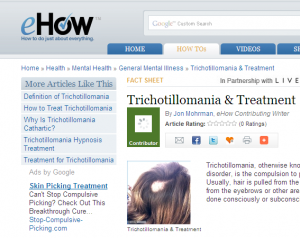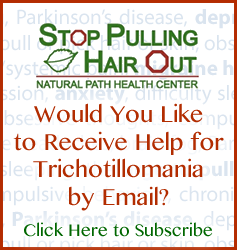A recent article entitled “Trichotillomania & Treatment” appeared on eHow. The article provides a cursory look at both the condition and the treatments for trichotillomania. We bring it to your attention because it neglects to mention a therapy that gets at the root cause of the problem – balancing neurotransmitters.
We understand the oversight. We’ve achieved success by using natural supplements to help rebalance the body’s neurotransmitters, but this is outside the mainstream approach. That’s a pity.
But it’s also not surprising, considering that the actual study of trichotillomania, as the eHow article notes, is also relatively new. The condition has only been officially recognized since the late 1980s.
That’s new by scientific standards. But to trichotillomania sufferers, that’s thirty long years. So what type of progress have we made to help relieve people of trichotillomania?
Therapies don’t include natural anxiety treatment
The article notes that cognitive behavior therapy (CBT) has been successfully used as treatment, “sometimes in conjunction with acceptance and commitment therapy (ACT) or antidepressants in severe cases.”
In several posts on this site, we’ve discussed the short-term effectiveness of most prescription drugs. Over time, they fail to deliver a successful solution.
CBT has definitely yielded some positive results. According to trich.org, “Methods of cognitive-behavior therapy, such as Habit-Reversal Training and the Comprehensive Model for Behavioral Treatment of Trichotillomania, have shown to be the most successful treatments known today.”
While CBT has seen some success, what we’re discovering is that is most effective when you also restore the neurotransmitter balance in the body.
How do you know which type of trichotillomania treatment to use?
To rebalance the neurotransmitter levels, we use supplements that provide amino acids and necessary cofactors to the body. Essentially, these act as the building blocks for neurotransmitters.
You need to take caution in just picking out any supplement, however. For example, a recent study pointed to the effectiveness of using N- Acetylcysteine (NAC) to help tame trichotillomania. You may want to link to the study.
We’ve found that NAC can be effective, but mainly as a secondary therapy. NAC helps with glutamate, which is a secondary excitatory neurotransmitter. We focus on the primary neurotransmitters (serotonin, dopamine, norepinephrine and epinephrine) as a first course of therapy. By correcting the primary neurotransmitter imbalance(s), the secondary neurotransmitter imbalance(s) often correct themselves.
The science behind our approach may sound a little confusing, but we are seeing dramatic results. The basic premise is that if we identify and address the root cause of imbalance in the brain chemistry, you will not only feel better, but you will benefit more from other complementary therapies. We believe the key to our approach is that we’re trying to incorporate all types of treatment, and use the ones that work most effectively together.
The combination of CBT and the correct supplements is proving to be beneficial to our clients. Our hope is that future articles like the one we mentioned earlier in this post will begin to recognize its effectiveness.


